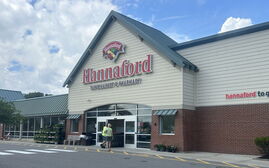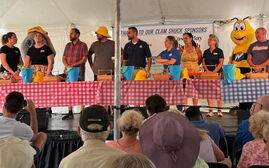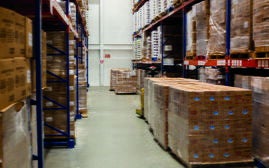Hannaford traces fish to the source
In May, Scarborough-based Hannaford Supermarkets announced a sweeping sustainability policy for all seafood products it sells, the culmination of more than three years of research and prep work. The policy applies to more than 2,500 products, including fresh seafood, and frozen, packaged and canned items in which the main ingredient is seafood.
As of March 31, the company now traces each product through the supply chain to its source and gathers information to ensure the fishery or farm is meeting certain criteria. Hannaford's 150 suppliers are required to demonstrate that they are harvesting seafood from fisheries governed by science-based management plans.
According to the company, dozens of suppliers have altered their harvesting practices, launched improvement projects and/or beefed up their documentation processes in order to comply with the policy. But, if a supplier can't prove a product's sustainability, it's removed from the shelves. More than 50 products, including mackerel, clam, tuna and crabmeat items, have been replaced with sustainable options.
Citing a United Nations statistic that 80% of the world's wild fisheries are overfished or stressed, George Parmenter, sustainability manager for Hannaford, says the company was focused not only on environmental sustainability, but business sustainability. “There were definitely issues that we couldn't ignore,” he says. “As a seller of seafood, we wanted to stay in business and be able to sell seafood long into the future.”
To craft this policy, Hannaford worked with the Gulf of Maine Research Institute in Portland. Jen Levin, GMRI's sustainable seafood program manager, says GMRI acted as a consultant to help Hannaford flesh out the details of its policy and determine the criteria on which products should be evaluated. GMRI continues to collect information from Hannaford's suppliers on where their products originate.
“The suppliers are responsible for understanding where their products are harvested and getting information about the source fishery, so we do fact-checking and help verify” the information is accurate, Levin says.
A year into the process, around March 2011, Hannaford was able to share the policy with its suppliers, giving them ample time to provide the needed information or improve their processes. Parmenter says the majority were willing to participate, and that many already had internal procedures to verify the sustainability of their products.
But verifying a product's source is not always easy, despite suppliers' eagerness to qualify. Parmenter says some suppliers are importing seafood from other countries and might not know the specific fishery or farm. And documentation provided might be in Chinese or Spanish, adds Levin. She credits GMRI's diverse set of researchers, who either hail from or have worked in foreign countries, for the organization's ability to take on the challenge.
Parmenter says customer response has been positive, and that consumers are asking questions and interested in knowing the source of their seafood. He said the policy hasn't resulted in a price increase, either for Hannaford or the customer.
Retail action
Hannaford says it's the first major U.S. supermarket to adopt such a comprehensive policy, but others, like Whole Foods and Walmart, have also announced efforts to source only sustainable seafood.
Levin says “most retailers” have some kind of policy, but they usually pertain only to products in the fresh case. “Hannaford's is the most sophisticated approach I've ever seen any retailer take,” she says. “Hannaford's [policy] pertains to all seafood in the store, even frozen fish sticks and canned tuna.”
She lauds Hannaford for its willingness to work with suppliers if they don't yet meet criteria, and its efforts to work with suppliers that demonstrate improvement.
She said other retailers will also write off an entire species if their supplier doesn't meet criteria. Whole Foods, for example, has stopped selling Chilean sea bass, orange roughy, Bluefin tuna and other species deemed especially vulnerable, according to its website, with plans to halt sales of other species in the next year.
However, each country has varying regulations for fisheries management, meaning cod fished from one source might meet sustainability guidelines, but cod from another might not. “It's far easier for a retailer to say, 'We don't sell cod,' or, 'we won't sell Chilean sea bass, or farm-raised salmon,'” says Levin, rather than assessing a species based on the management of the source as Hannaford does.
Hannaford's policy is part of a growing movement behind sustainable seafood, says Dane Somers of the Maine Lobster Promotion Council. “I think it raises the bar a little bit for everyone, and for a product to be associated with a company like that,” he says of Hannaford's policy. “It obviously adds value to have a certification process, but for Maine lobster, it's not going to be a surprise,” since he says many consumers already recognize Maine lobster as being sustainably harvested.
Sebastian Belle of the Maine Aquaculture Association says Hannaford's policy is the “most aggressive in terms of sustainability.” Hannaford uses certification from the Global Aquaculture Alliance for farm-raised seafood, which Belle says is the most widely accepted certification program for aquaculture products (though he qualified the statement to say that he serves on the alliance's board). He didn't know how many of Maine's 180 farms have GAA certification, but said Maine's operations have been “ahead of the crowd” when it comes to sustainability and were among the first to earn certification in 1994.
Ben Martens, executive director of the Maine Coast Fishermen's Association, says Hannaford's policy will help New England fisheries, since many species don't have a certification because they're listed as overfished.













Comments